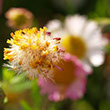The daisy is a universal symbol of life because it mirrors the life-sustaining source of the sun. It is also a universal symbol of happiness. One cannot look at a daisy and not be moved by its attributes. It epitomizes childlike simplicity, purity, and natural beauty. It also exemplifies awareness and a sunny disposition. After folding for the night or bad weather, its flowers greet the sunlight by opening to their celestial counterpart and adjust to its position as the day progresses. Hence, its name derives from "day's eye." Daisies are also representations of cooperation and peaceful coexistence. They are comfortable in one another's company and share their space, often supporting one another by intertwining and providing shade, retaining moisture, improving soil conditions, protecting seedlings, and stemming erosion for one another's benefit. They remind us that we, like they, are among a myriad of other, similar individuals. If we look closely at what we deem to be their flower, we can discover that it is in fact a cluster of many tiny flowers that arrange themselves for best overall effect.
But daisies are more than symbols in themselves. They are the archetype of a family that covers the world in far over 20,000 species, only avoiding the most extreme regions. These offer sustenance for wild and domestic animals. A number of varieties, including sunflowers, lettuce, artichokes, sunchokes, chicory, and dandelion are cultivated or harvested in the wild by humans for food. Some species possess healing powers. Some carry special properties that make them useful in a surprising variety of other uses. Many species can exist under poor conditions, creating a foothold for other plant and animal species and thus spreading the reach of life. The daisy family therefore embodies nourishment, assistance, and health.
Daisy seeds ride the wind on minuscule parachutes or attach themselves to animals to find an existence in places unknown. Once they take hold, daisies display a truly wondrous will to survive and make the best of their circumstances. I have childhood memories of daisies growing in concrete cracks, and some even buckled and broke through asphalt that had been laid over them. They are among the first plants to reclaim any kind of scar humans leave on the landscape. Thus, the daisy stands for the resilience and irrepressible claim of life to existence. It represents an intrepid attitude in the face of uncertainty and adversity, as well as a quiet confidence that obstacles can be overcome and mistakes can be remedied.
The daisy also gives us lessons on perspective. Some people may regard it as a weed because it invades their lawns and manicured gardens, when in fact these are unnatural conditions and daisies just stand their ground in what ought to be a harmonized habitat by the standards of nature. Its disarming wholesomeness makes us call into question a mindset that would be upset by its presence and would attempt to destroy and ban it. It also makes us question our artificial stance against beneficial forces of nature. Even varieties that invade our fields put us on notice that our monocultures are hurtful to the system of life and that it is trying to heal itself by injecting variety.
More generally, the daisy reminds us that great success can be achieved by gentle insistence. But it also confronts us with the insight that we will not be here for long and must try to enjoy every day we have.
Daisy
click daisy to return to
Reflections table of contents
close
menu

back to top
© 2013-2025 BY MARTIN JANELLO

